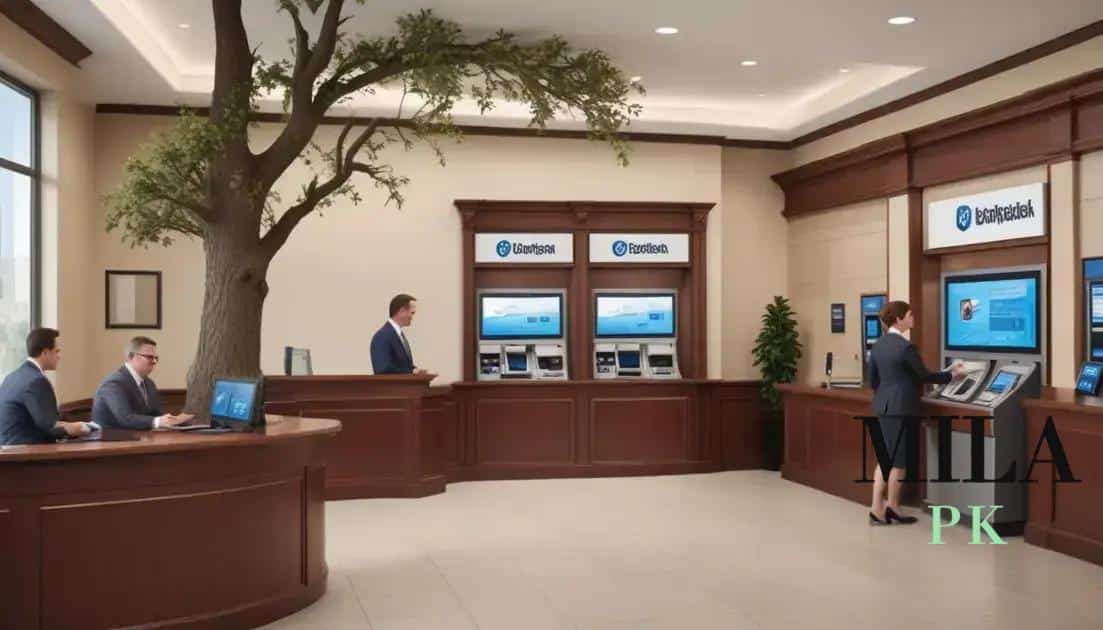Regional banks reevaluate physical location strategy

Regional banks are reevaluating their physical location strategies by integrating advanced technology, emphasizing sustainability, and enhancing digital services to better meet changing customer expectations.
Regional banks reevaluate physical location strategy as they respond to evolving customer behaviors. Have you noticed how banking is changing? Let’s dive into what this means for your local bank.
Understanding the shift in banking habits
Understanding the shift in banking habits is essential for regional banks aiming to thrive in today’s marketplace. Customer preferences are evolving, and banks need to adapt to stay relevant.
Key Changes in Consumer Behavior
Many consumers now prefer digital banking over traditional branch visits. This shift has led to a fundamental change in how banks operate. Customers are seeking convenience and immediate access to their financial information.
- The rise of mobile banking apps
- Increased online transactions
- Preference for 24/7 access to services
- Demand for personalized banking experiences
These factors are influencing banks to reevaluate their physical locations. Branches that were once bustling are now seeing fewer visitors. Customers enjoy the flexibility and speed that digital services provide.
Impact of Technology on Banking
Technology plays a significant role in shaping these banking habits. Innovations like contactless payments and AI chatbots are changing the way customers interact with their banks. With these tools, banks can enhance customer engagement and streamline services.
Moreover, the pandemic accelerated these trends. Many people became accustomed to managing their finances from home, further reducing the need for in-person banking. As banks embrace technology, they’re also learning to cater to a broader audience.
Future Outlook for Regional Banks
The future holds both challenges and opportunities for regional banks. They must find the right balance between physical and digital services. As they adapt, regional banks can thrive by focusing on customer experience and convenience.
- Investing in digital infrastructure
- Rethinking branch locations
- Offering hybrid service models
- Emphasizing customer relationships
By understanding the shift in banking habits, regional banks can position themselves strategically in a competitive environment.
The role of technology in banking evolution
The role of technology in banking evolution cannot be underestimated. As customer needs change, technology is paving the way for a new kind of banking experience. Innovations are transforming traditional banking methods, making them faster, more efficient, and customer-friendly.
Technological Advancements Shaping Banking
One significant advancement is the use of mobile banking. Customers now have the ability to access their accounts, transfer funds, and pay bills through their smartphones. This easy access has reshaped how we view banking.
- Mobile apps offering on-the-go banking
- Artificial Intelligence for personalized services
- Blockchain for secure transactions
- Virtual assistants for customer support
Additionally, security technology has become paramount. With the rise of online banking, customers demand safe transactions. Innovations like biometric authentication and advanced encryption help protect sensitive data and enhance trust.
Customer Engagement through Technology
Engaging customers through technology plays a crucial role in the evolution of banking. Banks now use data analytics to understand customer behavior better. By personalizing services, banks can meet individual needs more effectively.
Furthermore, the advent of chatbots has changed customer interactions. These AI-driven tools provide immediate responses, ensuring that inquiries are handled quickly. As a result, customers enjoy a seamless experience that keeps them coming back.
The Future of Banking Technology
As we look ahead, the adoption of technology in banking will only continue to expand. Regional banks must stay abreast of trends to remain competitive. Embracing new technologies not only enhances operational efficiency but also enriches customer relationships.
- Utilizing big data for customer insights
- Implementing cloud technology for flexibility
- Developing innovative financial products
- Fostering collaborations with fintech companies
Through these changes, regional banks can redefine their strategies, ensuring they meet the evolving demands of their customers. With the right technology, the future of banking looks promising.
Benefits of flexible bank locations
The benefits of flexible bank locations are becoming increasingly important in today’s fast-paced world. As customer demands shift, banks must adapt their strategies to remain competitive. Flexible locations allow banks to meet clients where they are, improving convenience and accessibility.
Enhanced Customer Experiences
By offering various banking options, customers can choose how and where they want to bank. Some may prefer physical branches while others opt for online services. This flexibility ensures better customer satisfaction, which can lead to loyalty.
- Personalized service at local branches
- Online banking for convenience
- ATMs in strategic locations
- Pop-up branches in high-traffic areas
Additionally, regional banks can respond quickly to customer feedback by adjusting their locations and services. If a certain branch is underperforming, they can pivot by opening a new branch in a more desirable area.
Cost Efficiency and Resource Management
Implementing flexible bank locations can also lead to cost savings. Traditional banking often involves maintaining large, fixed locations. By adopting a more flexible approach, banks can reduce overhead costs while maximizing outreach.
For example, pop-up branches or kiosks allow banks to serve clients without the commitment of a permanent location. This strategy allows for more efficient use of resources, making it easier to allocate funds where they will be most effective.
Adapting to Market Trends
The ability to adapt locations based on market trends is vital. As consumer behavior changes, banks must remain agile to succeed. Flexible locations enable banks to align their services with shifting demographics and preferences.
- Identifying high-demand areas for banking services
- Expanding into underserved communities
- Offering services in non-traditional environments
- Collaborating with local businesses for shared spaces
In conclusion, embracing the concept of flexible bank locations can significantly enhance a bank’s ability to serve its customers effectively. Whether through innovative service models or strategic location adjustments, regional banks can improve their overall impact and stay competitive.
Customer expectations and their influence

Customer expectations play a vital role in shaping how banks operate. As consumers become more informed and tech-savvy, their demands for banking services evolve. Understanding these expectations is crucial for regional banks aiming to enhance their offerings.
Rising Demand for Convenience
Today, customers expect convenience in their banking experiences. They want to manage their finances quickly and efficiently, with minimal hassle. This shift has led to a rise in mobile and online banking services, where clients can perform transactions at any time.
- Easy access to accounts via mobile apps
- 24/7 customer support through chatbots
- Quick loan applications and approvals
- Real-time notifications for transactions
Moreover, banks that offer flexible service options can meet these rising expectations. When customers have choices, they feel more in control of their banking experience.
Personalization and Customer Relationships
Another significant expectation involves personalization. Customers want services tailored to their individual needs. With advancements in data analytics, banks can now better understand their customers’ behaviors and preferences.
For instance, personalized banking solutions can include custom financial advice or targeted product offerings. This individualized approach not only enhances satisfaction but also builds stronger relationships between banks and clients.
Trust and Security Concerns
As digital banking grows, so do concerns about security. Customers expect their personal and financial data to be protected. Banks must focus on implementing robust security measures to meet these expectations.
- Two-factor authentication for transactions
- Regular updates on security protocols
- Transparent communication about data protection
- Incident response plans for potential breaches
When banks prioritize security, they not only meet customer expectations but also build trust. This trust is crucial for maintaining loyalty in a competitive market.
In summary, understanding customer expectations is essential for regional banks. By responding effectively to convenience, personalization, and security demands, they can strengthen their market position and enhance overall customer satisfaction.
Future trends in regional banking
The future trends in regional banking are shaping how banks operate and engage with customers. As technology evolves and consumer preferences change, regional banks are adapting to stay ahead of the curve.
Integration of Advanced Technology
One major trend is the integration of advanced technology into banking operations. Banks are increasingly using artificial intelligence and machine learning to improve services. These technologies help analyze customer data, enabling banks to offer personalized products and services.
- AI-driven chatbots for customer service
- Predictive analytics for targeted marketing
- Automated fraud detection systems
- Streamlined loan processing with AI
By leveraging these tools, regional banks can enhance efficiency and foster stronger customer relationships. As technology continues to advance, the reliance on these tools will only grow.
Emphasis on Sustainability
Another significant trend is the emphasis on sustainability. Many consumers today are more eco-conscious and prefer to work with banks that align with their values. Regional banks are responding by adopting sustainable practices and supporting green initiatives.
This can include financing environmentally friendly projects or investing in renewable energy solutions. By positioning themselves as sustainable organizations, banks can attract new customers and retain existing ones.
Expansion of Digital Services
As customers increasingly prefer online interactions, regional banks are expanding their digital services. Providing an intuitive digital banking experience is essential for meeting customer expectations. Customers want to manage their finances on-the-go and expect seamless access to banking services.
- User-friendly mobile applications
- Comprehensive online account management
- Digital wallets and contactless payments
- Virtual financial advisory services
Regional banks that excel in digital offerings will be better positioned to compete in the changing landscape. This evolution will help foster loyalty among tech-savvy customers.
As we look ahead, regional banks that proactively adapt to these future trends will not only survive but also thrive in an ever-changing financial environment. Embracing technology, sustainability, and enhanced digital services is key to their success.
In conclusion, the regional banking landscape is evolving rapidly due to changing customer expectations and advancements in technology. As banks embrace flexibility in their locations and adapt their services, they can better meet the needs of modern consumers.
By focusing on sustainable practices, personalized solutions, and enhanced digital offerings, regional banks can position themselves for success. Embracing these trends not only strengthens customer relationships but also ensures their relevance in a competitive market.
FAQ – Frequently Asked Questions about Regional Banking Trends
What are the key trends in regional banking?
Key trends include the integration of advanced technology, emphasis on sustainability, expansion of digital services, and a focus on enhancing customer experience.
How is technology transforming regional banking?
Technology, like AI and machine learning, helps banks provide personalized services and improve efficiency in their operations.
Why is sustainability important for regional banks?
Sustainability is important as customers increasingly prefer banks that practice eco-friendly methods and invest in sustainable projects.
What role does customer experience play in banking?
Customer experience is crucial; providing personalized solutions enhances customer satisfaction and fosters loyalty in a competitive market.





